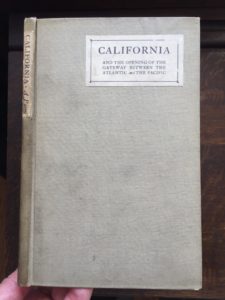
What would motivate an author to publish anonymously? The reviewers of California and the Opening of the Gateway Between the Atlantic and the Pacific wondered the same thing. There must be something wrong, they thought. “Writers who prefer to have their productions appear anonymously are usually moved by one motive, a lack of self-confidence in their own powers,” wrote The Saturday Chronicle in New Haven, Connecticut. However, the reviewer continued “But the man who wrote California must have had some other reason for withholding his name. There is a true feeling for poetical form in these stately and musical lines.”
The review must have both pleased and infuriated the author, who was a woman: Margaret Cutter. I had not known her name until earlier this month, when it was brought to my attention by Simon Taylor at Left Coast Books in Santa Barbara. Simon discovered Margaret’s signature in a copy that he had for sale. In the same hand, at the end of the poem, are the words “August 1914,” presumably noting when Margaret completed the poem.
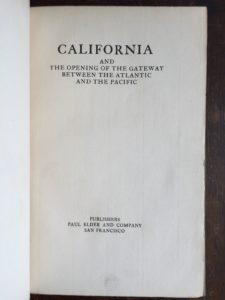
California was clearly meant to dovetail with San Francisco’s big party, the Panama-Pacific International Exposition, held from February to December, 1915, in what is now the Marina District. The Fair was ostensibly to celebrate the opening of the Panama Canal, but was really designed to show the world that San Francisco had recovered from the 1906 earthquake and fire. The book’s foreword is an excerpt from the 1657 book Cosmographie by the English ecclesiastical writer Peter Heylyn (1599-1662), where he attempts to describe every aspect of the known world: geography, weather, politics, and religion. Concerning the New World, he writes that the isthmus of Panama
…is so small a Ligament for so great a Body, that some have thought of turning these two Peninsulas into perfect Islands. Certain it is, that many have motioned to the Council of Spain, the cutting of a navigable Chanel through this small Isthmus; so to shorten their common Voyages to China and the Moluccas.
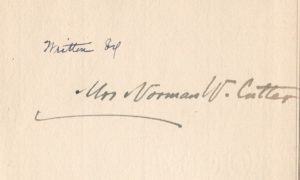
But though Margaret’s poem was completed in August 1914, the book was not published until October 1916, a full ten months after the PPIE closed. Any number of personal or financial issues, on Cutter’s side or Elder’s, could have caused the long delay, but assuming the book was intended for sale (as opposed to a vanity publication), not being able to feature the book at Elder’s booth in the Palace of Liberal Arts was surely a big disappointment.
The poem California is in two parts. In Part I, Cutter’s verses tell of the discovery of California by the Spanish, with brief mentions of the Chinese traders and the arrival of the Americans overland from the East during the Gold Rush. In Part II, Cutter uses the blossoming of California’s weather in February as a metaphor for the opening of the PPIE in February, 1915. She then describes California’s arms as open wide to the world, just as they were in 1849 when the world rushed in:
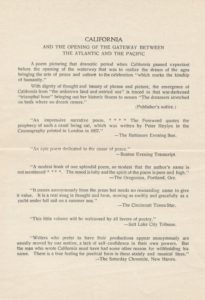
So once again does California call,
Glad invitation gives to festival,
The world invites to celebrate
The passage of the newly opened strait.
Bids men to keep triumphant jubilee
Which marks the kinship of humanity;
Her Golden Gate wide open set
For the world’s armament in glad truce met,
Her valley vestibules fresh strewn
With petals of the almond bloom.

It’s not a particularly attractive book. The design hearkens back to the Elder & Shepard days, before the heyday of John Henry Nash’s Arts & Crafts aesthetic at the Tomoye Press. The text is set in Caslon, more austerely than Herman Funke’s typical work with Elder. There is generous white space at the bottom and sides of the pages. The title page, half-title, copyright page, and colophon are set in all caps. The cover and spine are unadorned except for pasted-on labels. Perhaps California is a vanity publication after all: Paul Elder might not otherwise have settled for this quality of work, or permitted the author to remain anonymous.
The book includes a dedication page reading “To the Cause of Peace,” no doubt referring to World War I raging in Europe. The dedication was surely a late addition: when Margaret completed her poem in August 1914 the hostilities had only just started, but by the time the PPIE opened six months later, the War had spread across the whole of Europe. Indeed, due to the War, international attendance at PPIE was far less than the organizers had hoped, and the pavilions of many European countries were smaller than planned.
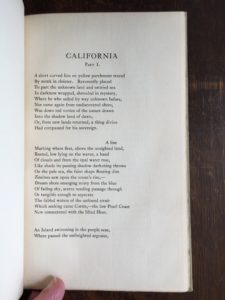
During her life, Margaret Cutter’s name was also recorded as Margaretta, Margarita, and Maggie, but in public she went by the formal name Mrs. Norman W. Cutter. She was born Margaretta Porter in Berlin, Connecticut in 1852. The Porter family traced its ancestry back to John Porter, born in Kenilworth, Warwickshire, England about 1590. John and his family left England and arrived in Dorchester, Massachusetts on 30 May 1630. Margaret’s grandparents, Norman Porter Sr. and Abby Galpin, were married in 1823. On their wedding day, they set off for Lexington, Kentucky, first by stagecoach and later by mule. There Norman setup shop as a merchant, and soon amassed “a small fortune,” enabling the Porters to live comfortably for the rest of their lives. They had a son, Norman Jr., and eventually moved back to Berlin. Norman Jr. married Hannah Peck in 1846; Margaret was the fourth of their six children. When Norman Porter Sr. died in 1863, Norman Jr. moved the whole family to San Jose, California. Margaret married Norman Webber Cutter on 15 April 1880 in San Jose. They had been married for only eleven years when Norman died at the age of 41 in 1891. They had no children, and Margaret never remarried. By 1910, she was living in Santa Barbara, and was still living there when she died in 1939 at the age of 87. She and Norman are buried together at Oak Hill Memorial Park in San Jose.
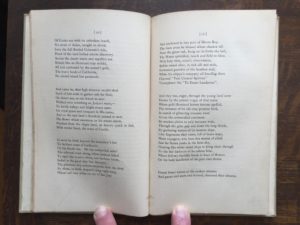
Despite the critical praise for her verses, Margaret Cutter appears never to have published another book. Everything points to her having inherited enough of her grandfather’s (or her husband’s) money to live comfortably. For example, either Margaret or Norman had collected a number of old and rare maps, which she donated them to Fort Lewis College upon her death.
My thanks again to Simon Taylor for discovering the mystery author.
